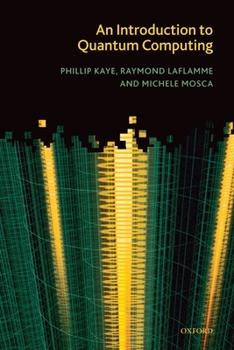An Introduction to Quantum Computing
Select Format
Select Condition 
Book Overview
This concise, accessible text provides a thorough introduction to quantum computing - an exciting emergent field at the interface of the computer, engineering, mathematical and physical sciences. Aimed at advanced undergraduate and beginning graduate students in these disciplines, the text is technically detailed and is clearly illustrated throughout with diagrams and exercises. Some prior knowledge of linear algebra is assumed, including vector spaces...
Format:Paperback
Language:English
ISBN:019857049X
ISBN13:9780198570493
Release Date:January 2007
Publisher:Oxford University Press
Length:288 Pages
Weight:0.98 lbs.
Dimensions:0.6" x 6.2" x 9.2"
Customer Reviews
3 ratings
A clear, concise book
Published by Thriftbooks.com User , 15 years ago
Compared to other books on the topic, this book offers a clear and concise treatment of quantum computing. The book's notation is also easy to follow. I recommended the book to my class.
Terrific choice for engineers interested in quantum computing
Published by Thriftbooks.com User , 17 years ago
This book is geared for the reader who has an undergraduate education in a technical field and who has a solid background in linear algebra, including vector spaces and inner products. Prior familiarity with topics such as eigendecomposition and more advanced mathematical topics is not required. The book reviews all of the necessary additional material. There are some places in the book where group theory is referred to, but these sections of the book are self-contained so that the reader can skip them if needed. It is a very accessible introduction to a complex subject that is fairly detailed and complete. Exercises are integrated into the body of the text. Each exercise is designed to illustrate a particular concept, fill in the details of a calculation or proof, or to show how concepts in the book can be generalized or extended. The following is a brief overview of the book: 1. Introduction and Background - Presents some fundamental notions of computation theory and quantum physics that will form the basis of what follows. 2. Linear Algebra and the Dirac Notation - Familiarizes the reader with the algebraic notation used in quantum mechanics, reminds the reader of some basic facts about complex vector spaces, and introduces some notions that may not have been covered in an elementary linear algebra course. 3. Qubits and the Framework of quantum Mechanics - Introduces the framework of quantum mechanics as it pertains to the types of systems that are considered in the book. Here the author also introduces the notion of a quantum bit or "qubit", which is a fundamental concept in quantum computing. 4. A Quantum Model of Computation - The circuit model of classical computation can be generalized to a model of quantum circuits. In such a model you have logical qubits carried along "wires" and quantum gates that act on the qubits. For convenience, the discussion is limited to unitary quantum gates. 5. Superdense Coding and Quantum Teleportation - Looks at our first protocols for quantum information. Examines two communication protocols that can be implemented using the tools which can be implemented using the tools developed in previous chapters. These protocols are known as superdense coding and quantum teleportation. Both of these are inherently quantum - there are no classical protocols that behave in the same way as these. 6. Introductory Quantum Algorithms - Describes some of the early quantum algorithms that are simple and illustrate the main ingredients behind the more useful and powerful quantum algorithms described in subsequent chapters. Since quantum algorithms share some features with classical probabilistic algorithms, the chapter starts with a comparison of the two algorithmic paradigms. 7. Algorithms with Superpolynomial Speed-Up - Examines one of two main classes of algorithms: quantum algorithms that solve problems with a complexity that is superpolynomially less than the complexity of the best-known classical algorithm
Great book
Published by Thriftbooks.com User , 17 years ago
For a beginner like me, I think this is a great book. I used to spend lots of time on N+C book but still got confused. This introduction to Quantum computing book has lots of illustrations explaining how things are done step by step inside those complicated algorithms. If you study on your own with this book, there should be no problem. Then you can go back to review N+C's book and things would be much more clear.





